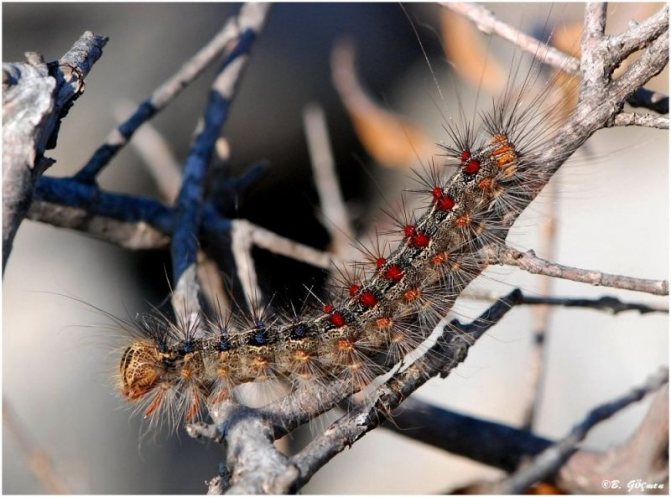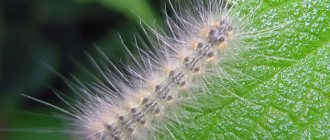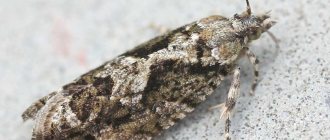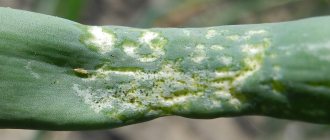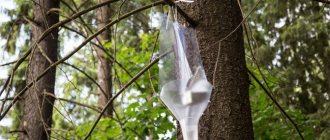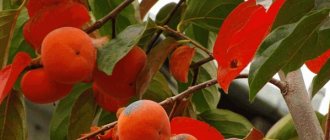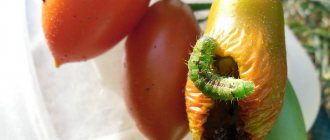Insect description
Appearance
The color of the pine cocoon moth is variable in tone from gray-brown to brown and resembles the color of pine bark. The upper wings of the butterfly are grayish-brown, decorated with a red-brown stripe bordered with black jagged lines. Closer to the head, on both wings, there is one well-visible small white spot. The lower wings and trunk are of a monochromatic gray-brown color.
The wingspan of the female butterfly reaches 9 cm, and that of the male - 7 cm. In addition, the male is distinguished by the structure of the antennae, which have a comb-like shape, while the female has thin threadlike antennae.
Reproduction
The pine cocoon moth is a dry-loving species and avoids damp habitats.
The most favorable places for its breeding are dry pine forests growing on hills. Butterflies begin to fly out in June and end their years in early August.
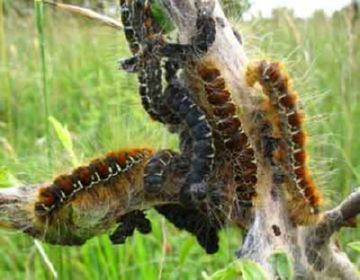
Beginning in mid-June, females lay eggs on needles, branches and bark of trees in heaps of 50 eggs. One butterfly can lay up to 300 eggs at once. The egg stage lasts 14 to 25 days.
In July or early August, young caterpillars emerge from the eggs, which, having matured, reach 8 cm in length. The color of the caterpillars is from brown to ash gray, and their hair is reddish. A pine cocoon moth caterpillar can be distinguished by two dark blue velvet stripes on the second and third body segments.
Food
The hatched caterpillars already on the second day begin to feed intensively, eating both old and young needles of trees. As a rule, the needles are eaten by voracious caterpillars before
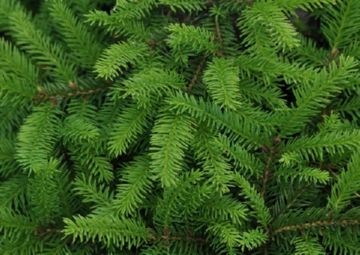

grounds. In the middle of autumn, the caterpillars descend from the tree for the winter, hiding under the moss or climbing into the litter of fallen needles. Some individuals climb into the ground for the winter to a depth of 10 cm.
In early spring, overwintered caterpillars emerge from their shelters, climb a tree and begin to devour old needles with renewed vigor. The expanded population is mistaken for fresh buds and shoots.
In mid-June, the caterpillar reaches the last stage of development and begins to create a cocoon around itself, and then turns into a pupa. At this time, elongated gray cocoons can be seen on the needles, branches of a tree or on its bark. After about three weeks, a butterfly emerges from the cocoon. As a rule, the development of the pine cocoon moth lasts one year, but some caterpillars hibernate twice, extending their development for two years.
Larva
The silkworm caterpillar resembles a white worm, earlier they were called that. The body is elongated with a head, abdomen, chest. Small horns are placed on the head - appendages. On the inner part of the body there are 8 pairs of legs, with the help of which the silkworm larva moves along the bark of a tree, leaves. The chitinous cover is quite dense, it performs the function of muscles. A photo of a silkworm caterpillar can be viewed below.
Larvae appear extremely small, no more than 1 mm in length, but with good appetite. exclusively with mulberry leaves, she is a mulberry tree, which is why the name of the insect came about.
The complete development cycle of a caterpillar is 45 days. During this time, 4 molts occur. Until the last stage, the caterpillar increases in size up to 30 times.Finally, the caterpillar forms a cocoon around itself of a silk thread, for the sake of which insects are grown. If you unfold one cocoon, you get the length of the thread from 300 to 1600 m.
Interesting!
Silkworm pupa of snow-white color. A butterfly develops inside for several days, gets out on its own. Shortly before that, you can hear the noise, feel the movement in the cocoon.
Appearance in North America
The history of the spread of the gypsy moth in this country is quite remarkable. The eggs of this parasite were brought by an amateur entomologist and astronomer Truvelot at the end of 1860. The researcher planned to conduct a series of experiments, during which he planned to cross a mulberry and a gypsy moth. Truvelot set up his experiments on his own site. Gypsy moth larvae quickly spread through the nearby forests. Truvelot immediately turned to his colleagues to solve the problem, but no action was taken at the right time. Only in 1889 was the gypsy moth recognized as a pest.


other methods
Prophylactic treatment of old trees with active compounds is very effective. For young plantings, however, it is better to use other methods. Fruit trees are processed with a mixture of kerosene and in a 1: 1 ratio. You can destroy cocoons during flowering. Among all the methods used, however, the most effective is spraying with modern insecticidal preparations. In early spring, you can use the viral drug "Virin-ENZH". At the beginning of flowering, the effective means are "Phosphamide", "Chlorophos", "Metaphos". The drug "Nitrafen" has proven itself quite well. However, it can be used before the buds appear on the trees.
Silkworm
The silkworm is so called because it feeds exclusively on the leaves of the mulberry tree. This insect is the only one that does not occur in the wild. It is used in the production of natural silk. This process is long and expensive, therefore the final product has a rather high price, but its quality is also high. For example, natural silk pillowcases are considered one of the best.
How is silk made?
- In special factories, an insect such as a silkworm is grown, a butterfly and its caterpillar are completely unremarkable in appearance: white, inconspicuous. When it's time to pupate, the caterpillar wraps itself in a cocoon. It is this cocoon that has value.
- The cocoon consists of a continuous thread, the length of which can reach 1500 meters. In general, the color of the cocoon (respectively, the thread too) can vary from light yellow to pink and even green-blue. But in factories only silkworms are bred, which produce a white thread, since then it will be easier to dye it in the desired color.
- Sadly, the butterfly will not come out of this cocoon, since no one gives her time to develop. After the formation of a silk cocoon, it is placed in an oven and kept there for about 2 hours. Of course, as a result of this, the caterpillar dies.
Food
Only the silkworm caterpillar or the mulberry worm feeds. The diet is monotonous - mulberry leaves. The tree is universal. Its wood is used in joinery. In Asia, it is used to make folk musical instruments.
We suggest that you familiarize yourself with: How to get rid of caterpillars on tomatoes
Despite the availability of food for silkworms, entomologists are constantly trying to find a replacement for mulberry leaves, at least temporarily. Scientists want to initiate early feeding of caterpillars and, in the event of frost or death of silk crops, have a backup option with food.


There are some successes in the search for a mulberry leaf substitute. First of all, it is a herbaceous plant called scorzonera. She throws out the first leaves in April.When feeding the caterpillars, the scorzonera demonstrated its suitability: the caterpillars consumed it, the quality of the thread did not deteriorate.
Dandelion, meadow goat and other plants showed satisfactory results. But their use is possible only on a temporary, irregular basis. With a subsequent return to mulberry. Otherwise, the quality of the final product deteriorates markedly.
Spread
Distribution of the gypsy moth in the United States by year
The unpaired silkworm is widespread throughout Europe, in Asia Minor, in Turkestan, in the Caucasus, throughout Siberia, in Japan and North America. This species is characterized by outbreaks of mass reproduction followed by devouring deciduous forests and orchards over large areas. Caterpillars eat foliage on almost all deciduous species, of which oak is especially fond of (Quercus
) and linden (
Tilia
), but ash (
Fraxinus
) and alder (
Alnus
) do not touch, as well as the pear (
Pyrus
); with a shortage of deciduous trees, they sometimes attack conifers and, destroying their seedlings in nurseries, bring noticeable harm. The Asian race of the gypsy moth is classified in Russia as a quarantine facility.
Previously, there was a popular story of the distribution of the gypsy moth in North America due to the carelessness of an amateur entomologist. It was believed that silkworm eggs were introduced to the United States in the late 1860s by the astronomer and amateur entomologist Etienne Leopold Truvelot for experiments on crossing this species with the silkworm (Bombyx mori)
Experiments were carried out on Truvelot's personal plot, but the larvae quickly spread through the nearby forests. Truvelo approached his colleagues to fix the problem, but no action was taken at the time. Only in 1889 was the gypsy moth recognized as a pest in the United States. It is currently believed that the number of escaped insects would not be enough to form a pest outbreak.
Damages
In various parts of its vast range, the gypsy moth is associated with various forest formations, various tree and shrub species. It can feed on many not only deciduous, but also coniferous species and, above all, local forest-forming species. In Europe, the Crimea, the Caucasus and the Far East, its main forage species are various types of oak and their companions.
Outside the geographical and ecological limits of oak forests, aspen and birch are the main fodder species of the gypsum, especially in the zones of small-leaved forests and the forest-steppe of Siberia; tree willows, poplars, elm and bird cherry - in floodplain forests; beech and hornbeam - in the mountain forests of the Carpathians, Crimea and the Caucasus; different types of larch - in the mountains of the Urals, Sayan, the Republic of Buryatia and the Chita region;
fir, larch, pine and cedar - in the forests of the Altai mountains; spruce, fir, apple, pear and maple - in the mountain forests of Central Asia. Due to these main forage breeds, the successful development and reproduction of the gypsy occurs in local conditions. But in the European part of Russia, he feeds on spruce forcibly, only after completely eating deciduous trees in the hearth.
| Defoliation | Defoliation (slope) |
Gypsy moth control measures
Prevention is undoubtedly considered the best insect repellent. Such measures help to prevent the appearance of not only this parasite, but also many others. If the gypsy moth has already settled on the territory, then you can use the mechanical removal of egg clutches. This option is considered the simplest. Periodically, you should inspect your site and check fruit shrubs and trees for the presence of nests of these insects on them. If a clutch of eggs is found, it should be scraped out and burned. This is the most effective way to kill larvae. Alternatively, you can bury the found masonry in the ground to a depth of at least half a meter.Protective agents should be used during work, since the hairs covering the eggs on top can cause allergies in contact with the skin. Collecting caterpillars is also considered an effective method. In this case, you can use special traps in the form of glue rings (oilcloth or paper cuts with a layer of natural resin or glue). They should be wrapped around the barrels. Moving through the tree, the gypsy moth will surely fall into a trap. With its insignificant mass, it will not be able to get out on its own. You can collect the larvae manually. However, in this case, it is imperative to provide protection to the skin.
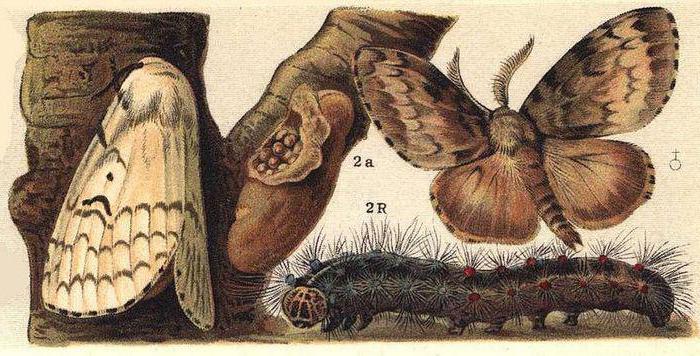

Development
Females lay eggs in the grooves of the bark of trunks and stumps, releasing them in heaps of several hundred pieces, and mix them with a yellowish-gray fluff that also covers them from above. Having laid eggs, the female may die immediately. Piles of eggs are sometimes covered with continuous fluffy rings at the base of the trunks and then come across on stones, buildings, etc. The eggs hibernate and tolerate moisture and cold without losing their vitality even after 10 days underwater. Rainy weather during the flight of butterflies interferes with their mating, and then females lay mostly unfertilized eggs, from which caterpillars do not develop.
Caterpillars hatch in early spring: they are covered with disproportionately long and numerous hairs, equipped with special extensions or bulges, thanks to which they are easily picked up by the wind.
Starting from June - mid-July, depending on the temperature regime, occurs. Pupae are attached by a net of numerous cobweb threads, while being placed low from the ground in cracks in the bark, on the lower branches, sometimes between half-eaten leaves tied by cobwebs. After 10-15 days, the flight of butterflies begins.
Why are they dangerous?
Both species are pests of both deciduous and fruit crops. They are capable of damaging more than 300 species of trees. Of the fruit crops, the gypsy moth prefers cherry, plum, pear and apple, and ringed - only apple.
Caterpillars that feed on leaves, young buds and flowers pose a danger to the garden.
One silkworm caterpillar can eat up to 30 young leaves in two months of its development. With a massive accumulation and without timely protection measures, gluttonous pests leave the tree absolutely without foliage. As a result, the plant dries up and dies. Five or six clutches of silkworm eggs in one tree is a serious threat to it.
How to deal with a pest
Biological methods
The pine cocoon moth has many natural enemies. Shrews and hedgehogs destroy caterpillars during the wintering period. The birds eat eggs, caterpillars, pupae and butterflies. Feathered enemies of the insect are cuckoos, tits, starlings, nuthatches, orioles, hoopoes, owls and other birds.
In addition, several species of flies, egg-eaters and wasps parasitize on the eggs of the cocoon moth, which also reduces the population size. Caterpillars also die, being struck by the disease caused by the muscardine fungus.
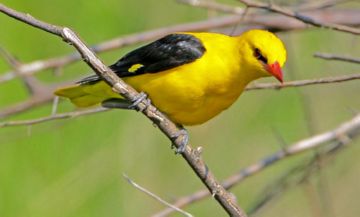

The elimination of small foci of pine cocoon moth attacks is successfully carried out using biological control methods. For this, additional dispersal of entomophages is used - insects, which are natural enemies of pine pests.
The most commonly used telenomus egg-eater, which parasitizes the eggs of the pine cocoon moth and leads to their death. Telenomus is propagated in the laboratory on pest eggs. Eggs infected with entomophage are transferred to developing foci before the beginning of summer of butterflies.
Telenomus settles very well. It is capable of spreading up to 300 meters from the release sites, effectively infecting fresh clutches of pine cocoon moth eggs.
Ants of the formica genus exterminate many harmful insects, including the pine cocoon moth. They successfully deal with his young caterpillars.Ant colonies are protected and, if necessary, can be resettled in the affected areas.
Chemicals
When a small population of pine cocoon moth is found, the infected area of the forest is isolated by glades and grooves so that the caterpillars cannot move to the trees that are not yet infected. The lower part of the tree trunks in an isolated area is ringed with a caterpillar glue trap, which prevents the caterpillars from crawling onto the trees. The glue ring is 4 cm wide and 3 to 5 mm thick. 40-50 kg of glue is used per 1 ha. These measures are carried out in early spring before the caterpillars come out of hibernation.
In the event of large foci of infection, territories are pollinated with various insecticides from aircraft.
The following consumption rates are used:


- Hexachloran - from 0.2 to 0.3 kg per hectare,
- Dust DDT (5-%) - from 15 to 20 kg per 1 ha,
- Benzophosphate - from 1 to 3 kg per 1 ha,
- Karbofos - from 1.2 to 4 kg per 1 ha,
- Metaphos - from 1 to 4 kg per hectare.
Another method of struggle is to apply a toxic ring 10 to 15 cm wide on tree trunks by spraying at chest level. For this, a pesticide solution is made at the rate of 4 kg per 1 hectare of adult trees and 10 kg per 1 hectare of young trees. This procedure is carried out in early spring before the caterpillars emerge from the shelters.
All chemical control methods are used only after careful monitoring. Insecticide treatment begins in early spring before the appearance of natural enemies of the pine cocoon moth, so as not to harm the beneficial inhabitants of the forest.
Of course, large populations of pine cocoon moth are extremely dangerous for our forest wealth. However, constant monitoring and timely measures taken to protect trees from the attack of gluttonous pests can put a barrier to the destruction of forests.
Insecticides
Chemical methods of control allow you to get the desired result within a few days. The broad-spectrum poison destroys butterflies within the first 2 hours after spraying plants, caterpillars - up to 30 days. Initially, the poison enters the body by contact through the chitinous cover. It affects the work of the nervous system, causes muscle paralysis, death.
For 2 hours, the active toxic substance enters the plant sap, silkworm caterpillars on the apple tree, and other plants die during feeding. Mass death occurs within a few days.
When working with insecticidal agents, you must observe safety measures - protect the respiratory tract, mouth, eyes, skin. Otherwise, an allergic reaction occurs, intoxication of varying severity.
Gardeners call the best drugs Actellik, Aktara, Karbofos, Fufnon. Poison is used in exceptional cases, if other methods of struggle do not help.
What does a gypsy moth look like?
Adult gypsy moths are butterflies, males and females of which have significant external differences. The wingspan of the female is from 6 cm and above, the color is dirty yellow with a zigzag pattern. The abdomen of the silkworm is yellow, large, with dark antennae on the head. Males are much smaller in size - wingspan do not exceed 4-6 cm. The abdomen of the male adult is brown, the color of the wings is also somewhat darker than that of the female.
Females live on average for several weeks, managing to lay up to 1000 eggs during this time. The egg clutch of the gypsy moth changes color over time from yellow to pink, so the degree of maturity of the larva is manifested. Eggs perfectly tolerate low temperatures, therefore, during the winter, the process of embryo formation does not stop, and by spring the gypsy moth caterpillars appear from them.
At the beginning of their life, the larvae are covered with small fluffs with bubbles, which allows them to be transported over short distances by gusts of wind. This contributes to the spread of the number of pests throughout the garden.Immediately after hatching from eggs, silkworm caterpillars begin to actively eat young shoots; it takes about a month for the insect to fully develop, during which the gypsy moth will actively spoil all green spaces. Apple and pear trees, plums and apricots are especially attractive to these insects, although they often settle on other tree species. In just a month, a hundred larvae can damage a significant part of the tree, so you should fight the gypsy moth quickly and mercilessly.
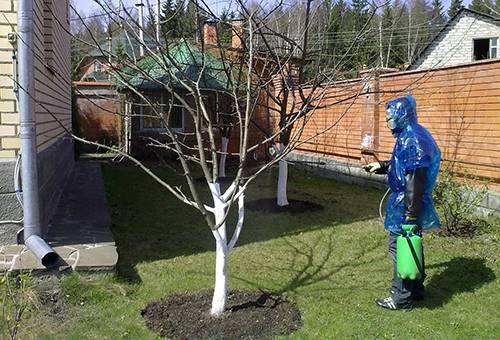

Reconnaissance supervision
the unmatched should be followed by leaf stubs, feces, lesions and caterpillars, as well as by butterflies and egg-laying. The first surveillance is carried out at the end of June, when caterpillar feeding ends. At this time, stubs of leaves and needles are clearly visible on calomeric plots, bare soil, and in other places.
On closer inspection, you can find pieces of feces here, and on the branches - damaged leaves and the caterpillars themselves. It is easier and better to supervise the unmatched bird in late July - early August for butterflies and egg-laying. However, it should be borne in mind that the location of oviposition of the testicles can be different. In lowland forests, the unpaired bird lays its testicles at the base of the trunks.
The fallen snow covers the egg-laying, and they overwinter safely under its cover. In winters with little snow and severe, when frosts reach 30 ° and more, egg-laying not covered with snow freezes out. In areas where winters are not so harsh, testicles are deposited not only at the base of the trunk, but also higher along the trunk and not even branches.
Females seek to cover the testicles, so they lay them in deep cracks in the bark of older trees, in wounds - on the trunks, under the peeling bark, under the washed-out roots of floodplain trees, from the sides and bottom on the root paws protruding above the ground, under the bends of the trunks at the base of the growth trees , in the hollows of trees and stumps, on the trunks inside dense clumps of undergrowth or undergrowth and in other secluded places.
During the years of mass breeding, egg-laying can be found on houses, buildings, fences, poles, benches and other buildings and structures. In forests, they are not always deposited on forage species. For example, ovipositions can often be found in cracks in the bark of old pines, in the absence of them - on neighboring young oaks, birches and other forage species.
In gardens, egg-laying is often absent on the trunks of fruit trees, even during the third phase of the outbreak, when they are en masse located on garden fences, buildings, and the trunks of old trees surrounding the garden. The described and other local features of oviposition cannot be ignored when conducting reconnaissance surveillance in order to avoid mistakes.
During supervision, the age of egg-laying should also be monitored. Freshly laid eggs are convex and firm to the touch. Ovipositions that have survived from last year are soft to the touch, empty, usually gray, not yellow or brown, and small holes are almost always visible on their surface, left after the emergence of caterpillars and the emergence of oviposites. Ovipositions damaged by skin beetle larvae, other predatory insects or birds have a tousled surface.
Butterfly and egg-laying reconnaissance surveillance should be considered the main method of gypsy moth surveillance due to its simplicity and clarity. It makes it possible to obtain the qualitative and quantitative indicators required for forecasting, especially in the second phase of the outbreak. The size of butterflies and their coloration, as well as the number of eggs in egg-laying, are qualitative indicators of an outbreak and its phases.
Therefore, during reconnaissance surveillance, it is necessary to collect female butterflies or their corpses, sort them by size and color, note the percentage of large and dark-colored butterflies. To determine the degree of threat to plantations from the gypsy moth, control samples of 10 trees should be laid, on which, as well as on undergrowth, undergrowth, stumps, etc., the number of egg-laying is taken into account.
Stationary supervision, stationary and detailed examinations are carried out on egg-laying. With any of these counts of egg-laying, the number of last year and the current year, the number of egg-laying of the current year, whole and destroyed by skin beetles, other predatory insects and pecked birds, are separately noted. The undamaged ovipositions of the current year are removed and each of them is placed in a separate bag, if there are few of them (when counting during the I and II phases of the outbreak).
If there are a lot of them (when counting during the III phase of the outbreak), then 10 ovipositions are taken from each sample: three of the largest, three of the smallest and four of average size, estimated visually. Each of the collected ovipositions is weighed and the number of eggs in them is determined by weight, or this number is determined by direct counting.
The weight of oviposites in the gypsy moth varies from 0.01 to 1.00 g, the number of testicles in them is from 10 to 1500, and the weight of female pupae is from 0.26 to 3.4 g.
According to the phases of the outbreak, these indicators vary within the following limits.
In the first and second phases of the outbreak, the maximum weight of pupae is 1.6 - 3.4 grams, with an average weight of 0.85 - 1.10 g. The maximum weight of egg-laying is 0.8 - 1.0 g, with an average weight of 0.5 - 0.6 g. The number of eggs in ovipositions is, respectively, 1000 - 1500 and 500 - 750 pieces.
In the third phase of the outbreak, the average weight of pupae is 0.5 - 0.6 g. The average weight of egg-laying is 0.2 - 0.3 g, with 250 - 350 eggs in them.
In the fourth phase of the outbreak, the average weight of pupae is 0.33 - 0.38 g, the average weight of oviposites is 0.08 - 0.12, with an average number of eggs in them 100 - 150 pieces. The minimum indicators are 0.26 g, 0.01 g and 10 pcs, respectively.
Then, the testicles are analyzed for their infestation by parasites, diseases, destruction by predators and infertility, taking 100 testicles from each sample without selection, establish the percentage of healthy ones and, according to this percentage, calculate the number of healthy testicles in one egg-laying on average, and by the number of healthy egg-laying on average per tree counts the number of healthy testicles on average per tree per sample and the threat to it from the unpaired bird in the coming year.
In cases where it is impossible to take into account and collect ovipositions (when they are found in the crowns of trees, in cracks and crevices of rocks, in tree hollows and other hidden places), their number, size and degree of threat from the gypsy to plantations are assessed visually.
When monitoring the gypsy moth, other accounting methods can be used: light, sexual and chemical. They should be used when egg production is difficult or impossible to account for, especially at the onset of an outbreak. When using the light method, you should take lamps that emit ultraviolet rays, such as mercury-quartz. Both males and females fly well on them. Even males fly much worse on ordinary lamps.
Control methods
There are many ways to deal with the gypsy moth. The optimal method is selected based on the degree of damage to the plants by the pest and the stage of development of the gypsum.
The main ways to deal with a gypsy are:


- collection and destruction of oviposites: in small areas of the forest or in small gardens, you can manually collect (scrape) the eggs of the gypsy moth, and then destroy them;
- destruction of egg clutches with the help of petroleum products: in autumn after leaf fall or in early spring on trees with thick bark, the eggs of the gypsum can be destroyed by covering them with oil, engine oil, kerosene;
- insecticide treatment of egg-laying;
- use of glue rings: sticky rings, which are attached to the trunks, prevent caterpillars from lifting from the egg-laying located at the roots into the crowns of trees;
- manual collection and destruction of caterpillars: this method can be used by owners of small gardens; insecticide treatment of trees in spring, at the beginning of the rise of caterpillars in the crown or after the completion of migration.
Characteristic
Male and female differ very sharply, both in shape and color - hence the name. The female is up to 9 cm wide in span; the forewings are yellowish or grayish white, with dark brown transverse, serrated and wavy stripes, with a black crescent or angular spot at the middle and a small round spot near the base; along the edging, between the veins, a row of rounded black specks, the abdomen is thick, with a brownish-gray downy at the end; antennae and tarsi black. Male up to 4 cm wide in span; antennae are feathery, brown; dark gray, with the same, but wider stripes and spots on the forewings, as in the female. Egg initially yellow, then yellowish or pinkish-gray, smooth, round, slightly flattened on top, 1-1.2 mm in diameter. [3] Caterpillar up to 7 1/2 cm in length, 16-legged, hairy, with three thin, sometimes inconspicuous, longitudinal stripes on the back and with paired warts, of which the front 5 pairs are blue, and the back 6 pairs are red; there is a tuft of hairs on each wart; on the 8th and 10th rings, two orange, less noticeable glands; the head is dark gray, with two longitudinal, kidney-shaped, black spots. Pupa dull black or dark brown, with sparse tufts of short reddish hairs and two pits behind the antennae.
Diagnostic signs
Butterflies
very variable in size and color. Females have a wingspan of 4 to 9 cm, white, often with a gray or brown tint. On the forewings there are four transverse black zigzag stripes, which can be developed to varying degrees up to their almost complete disappearance. In the median cell there is a black dot, and on the transverse vein there is a black angular spot.
Fringe of front and hind wings with black spots. The abdomen is thick, yellowish, bearing a pillow of dark or yellow-brown hairs at the end. Antennae black, slightly combed. The male has a wingspan of 3 to 5 cm, grayish-brown, yellow or brown, the color of dry leaves lying on the ground, among which he day.
Forewings with the same, as in the female, four transverse zigzag stripes, round and angular spots of black or almost black color, which are preserved in different individuals, but the details of the pattern are still variable. The hindwings are lighter in color, with a darker outer margin. Fringes of the wings with dark brown spots. The abdomen is not thick, conical. Antennae are comb.
At the beginning of mass reproduction, dark-colored butterflies with a well-developed pattern in females dominate.
It should be noted that gypsy females, burdened with testicles, fly poorly, especially at the beginning of mass reproductions, when their fertility is at a high level, but they can be carried over considerable distances by strong winds.
Testicles
spherical, somewhat flattened at the poles, 0.8 X 1.3 mm, smooth, shiny, freshly deposited - pinkish; further turn yellow and gray as the embryo develops. Testicle weight from 0.39 to 1.22 mg. The female lays the testicles in one pile, interlayers them and covers them from above with hairs from the abdomen, which gives the pile a color from light to dark brown.
- Imago, female (egg-laying)
- Mass oviposition
Caterpillar
freshly hatched, 16-footed, light yellow, rapidly darkening, with a dull black head and six longitudinal rows of warts bearing long, thin and short bristle-like hairs (aerophores). Caterpillars of this age are very similar to caterpillars of nuns and differ from them by their matte black head. Like nun caterpillars, they can be carried by the wind over considerable distances.
The ability of caterpillars of the first instar to settle downwind plays a huge role in the dynamics of foci, in their expansion, movement, disappearance, and in the emergence of new ones. The same ability of caterpillars gives them the opportunity to find food in those cases when the female lays eggs on rocks, buildings, fences, tree trunks, where there is no food for caterpillars, and in other cases.
- "Mirror"
- Male (1st age)
- Male (2nd age)
- Male (3rd age)
- Male (4th age)
- Male (5th age)
- Female (1st instar)
- Female (2nd instar)
- Female (3rd instar)
- Female (4th instar)
- Female (5th instar)
- Female (6th instar)
more often gray. But their general color can be different - from light yellowish brown to dark velvety black. It is always easy to distinguish them from all other caterpillars by the color of the dorsal warts: the front five pairs are colored blue, and the next six pairs are red; on the 9th and 10th segments, one orange poisonous gland is located between the red warts. Four rows of lateral warts are gray with long hairs.
We invite you to familiarize yourself with: The drug Stomorgil is an effective agent in the fight against bacterial infections in veterinary medicine
The feces of caterpillars have the shape of several angular cylinders with six deep longitudinal grooves. The length of the pieces of feces is somewhat greater than their thickness and is close to the width of the head of caterpillars of the age to which these pieces of feces belong. Fresh feces are greenish-dark brown, quickly turns black.
Chrysalis
from dark brown to black, matte or with a low sheen. The dorsal side, head and abdomen are covered with bunches of short, not dense red hairs sitting on indistinct warts. Base of 5-7th, and in male pupae only 6th abdominal tergites, with few but sharp transverse grooves; other tergites with unsharp punctures and wrinkles.
- Pupation
- Chrysalis
- Pupa, male (top)
- Pupa, male (bottom)
Description
As mentioned above, the male and the female have significant differences. They appear both in shape and color. The female reaches 9 cm. Her front wings are slightly yellowish or grayish white, with wavy, serrated and transverse dark brown stripes. On the wings there is also a black lunar or angular spot in the middle and a small round one at the base. A number of black spots are located between the veins along the rim. They are also black. Females have a thick abdomen, at the end of which there is a brownish-gray down. Their paws and antennae are black. Males reach 4 cm in width in wingspan. Their antennae are brown, feathery. The male is dark gray. On the front wings are the same as on the female, but with wider stripes and spots. Gypsy moth eggs are yellow at first. Over time, the color becomes yellowish or pinkish gray. The egg has a smooth surface, round, slightly flattened at the top. Its diameter is 1-1.2 mm. The caterpillar can reach up to 7.5 cm. It has sixteen legs, a hairy body. On the back there are three thin, in some cases almost invisible longitudinal stripes, and paired warts, five of which are blue, and six of the back are red. Each wart has a tuft of hairs. Caterpillar head It has two longitudinal black, kidney-shaped spots. The pupa of the silkworm is dark brown or dull black. On it one can see rare bundles of reddish short hairs and two pits behind the antennae. The adult gypsy moth does not have a mouth apparatus.


Phenology
flight of butterflies - July (2,3), August (1); eggs - July (2,3), August - March (1-3);
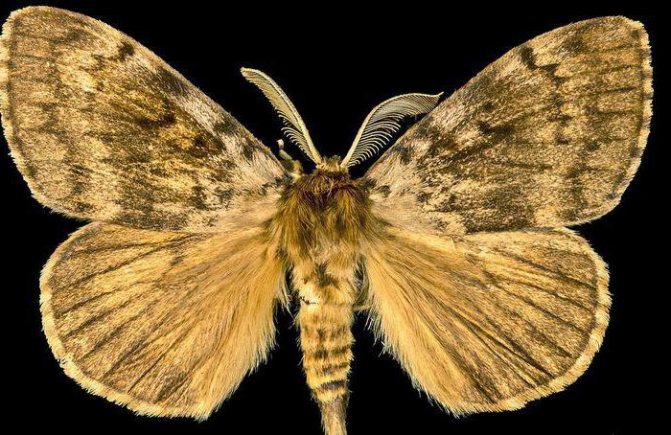

eggs - April (1-3), May (1); caterpillars - April (3), May, June (1-3), July (1); pupae - June (3), July (1-3); flight of butterflies - July (2,3), August (1);
Note: the decades of the month are indicated in brackets.
Caterpillars that give males molt four times during their development and go through five instars. Caterpillars producing females molt five times and have six instars. The ages are distinguished by the width of the head. In the first age, the width of the head capsule is 0.6 mm, in the second - 1.2 mm, in the third - 2.2 mm, in the fourth - 3.2 mm, in the fifth - 4.4 mm, in the sixth - 6.0 mm.
Autumn development of the testicles takes place at a temperature of 7 ° and more and requires up to 300 ° of the sum of the average daily temperatures of the period of testicular development.For example, if during this period the average daily temperature is 15 °, then the autumn development of the testicles before they fall into diapause will take 300: (15-7) = 37.5 days.
Spring additional development of eggs begins at temperatures above 6 °. For their further development, it is required up to 110 ° of the sum of the average daily temperatures exceeding 6 °, i.e. at an average daily temperature of 15 °, development ends at 110: (15-6) = 12 days.
In nature, the hatching of caterpillars from the testicles usually coincides with the budding of an early form of summer oak. The development of caterpillars producing females requires the sum of average daily temperatures of about 740 °, for the development of caterpillars producing males - about 650 °, and the threshold for feeding and development is the average daily temperatures exceeding 6 °.
The most favorable optimal average daily temperatures are 22 - 27.5 °, on average 25 °, at which the development of caterpillars producing females ends at 39 days, and males at 34 days. The development of pupae, giving females, requires a sum of average daily temperatures of about 140 °, and of giving males, about 170 ° with a developmental threshold of 9 °. So, at an average daily temperature of 25 °, the development of pupae of females ends at 7.4 days, and males - at 9 days.
The unpaired bird, in particular its caterpillar, is resistant to fluctuations in relative humidity.
For the full development of eggs (in spring), caterpillars and pupae, the sum of average daily temperatures of about 990 ° is required for females, and about 930 ° for males, with a developmental threshold of 7 °. For example, at average daily temperatures of the entire developmental period of 20 °, females will develop within 76.2 days, and males - 71.5 days. In nature, this development lasts 60 to 80 days.
Each caterpillar eats 8 - 10 times more leaves by weight than the pupa developing from it weighs in its life. Since the weight of individual pupae of the gypsy moth (males and females) ranges from 0.07 to 3.5 g, the weight of foliage eaten by caterpillars can range from 0.6 to 35 g, and the amount of foliage eaten increases dramatically with age.
- Butterfly on the trunk, female
- Female (above) and male (below) (relative sizes of male and female are not observed)
- Oviposition on the trunk
- Egg-laying on a Mongolian oak leaf (a regional feature of the gypsy bird in the Far East)
- Gypsy moth caterpillar
- Male and female gypsy moth emerged from pupae
- Gypsy moth eating birch
What harm does an insect do
It should be remembered that each insect brings a specific benefit to green space. The pine cocoonworm, which can be called a forest orderly, is no exception. Its caterpillars primarily eat old needles on sick and weakened trees.
When the population becomes too large, the pine cocoon moth turns into an extremely dangerous pest of pine forests.
The greatest damage to forestry is caused by the caterpillars of the cocoon moth, which eat needles at all stages of their development and especially intensively after wintering, from early spring to the moment
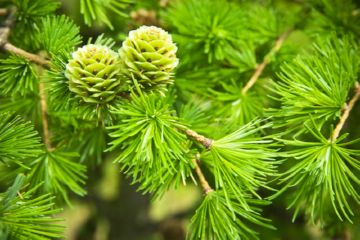

pupation. Gluttonous caterpillars harm not only pine forests, they can also feed on the needles of cedar, larch and spruce.
One adult caterpillar eats up to 60 needles per day, and for the entire period of development up to pupation - about 1000 coniferous needles (about 36 g). Such an intensity of pine needles eating leads to the fact that the damaged trees do not have time to recover and completely dry out.
In dry years, which are the most favorable for pest breeding, numerous caterpillar populations are capable of destroying tens of thousands of hectares of pine forests. A massive outbreak in the same places can last for about 5 years. In the event of lesions occurring in forestry, an intensified fight against the pine cocoon moth is conducted.
Preferred stations
The unpaired silkworm is a pronounced dry-loving and light-loving insect.The primary foci of its outbreaks arose in older sparse stands, open spaces, shelter belts and along the southern edges of fuller stands, consisting of an early form of summer oak or birch, and along floodplains and rivers, in plantations of poplar or willow trees older than 20 years.
Even more often, the reservations of the gypsy grass, turning into primary foci, were confined to plantations located in the immediate vicinity of settlements or near them and characterized by the sparseness of the first tier, the absence of the second tier and especially soil-protective undergrowth, as well as grassy cover, hunted by excessive and long-term grazing unauthorized cuts and breakdowns.
In upland forests, primary foci were formed in sparse plantations located on the slopes of the southern points and in a complex of conditions similar to steppe and forest-steppe oak forests. Gypsy reservations, which turned into foci of local outbreaks, and later, during droughts, developed into foci of large outbreaks, were also confined to birch forests in peat bogs or to alder forests in bogs.
In all these cases, the reservations and foci were characterized by physically and physiologically dry growth conditions (dry sandy loam, salt licks, solonetzic loams, peat bogs, waterlogged soils, etc.), extreme depletion in the protective properties of plantations as biocenoses (birds, predators, parasites and diseases), weakening trees themselves.
Secondary foci were created in plantations of fuller, younger, more preserved, more complex composition and layering, belonging to the group of fresh (for example, glazed) oak forests located on the western and eastern slopes of the mountains, which are less heated and more humid.




